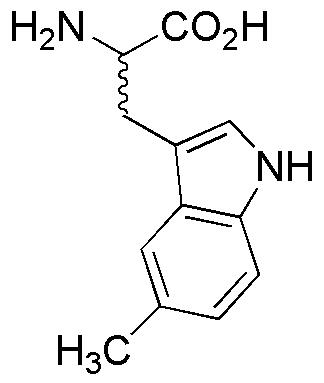5-Methyl-DL-tryptophan is widely utilized in research focused on:
- Neuroscience Research: This compound serves as a valuable tool for studying serotonin metabolism and its effects on mood and behavior, helping researchers understand mental health disorders.
- Pharmaceutical Development: It is used in the synthesis of novel drugs targeting serotonin receptors, potentially leading to new treatments for depression and anxiety.
- Animal Nutrition: In veterinary science, it is incorporated into feed formulations to enhance the growth and health of livestock, promoting better feed efficiency.
- Biotechnology: The compound is employed in metabolic engineering to produce tryptophan derivatives, which can be used in various bioprocesses.
- Food Industry: It acts as a dietary supplement, improving the nutritional profile of food products by enhancing tryptophan levels, which is essential for protein synthesis and overall health.
General Information
Properties
Safety and Regulations
Applications
5-Methyl-DL-tryptophan is widely utilized in research focused on:
- Neuroscience Research: This compound serves as a valuable tool for studying serotonin metabolism and its effects on mood and behavior, helping researchers understand mental health disorders.
- Pharmaceutical Development: It is used in the synthesis of novel drugs targeting serotonin receptors, potentially leading to new treatments for depression and anxiety.
- Animal Nutrition: In veterinary science, it is incorporated into feed formulations to enhance the growth and health of livestock, promoting better feed efficiency.
- Biotechnology: The compound is employed in metabolic engineering to produce tryptophan derivatives, which can be used in various bioprocesses.
- Food Industry: It acts as a dietary supplement, improving the nutritional profile of food products by enhancing tryptophan levels, which is essential for protein synthesis and overall health.
Documents
Safety Data Sheets (SDS)
The SDS provides comprehensive safety information on handling, storage, and disposal of the product.
Product Specification (PS)
The PS provides a comprehensive breakdown of the product’s properties, including chemical composition, physical state, purity, and storage requirements. It also details acceptable quality ranges and the product's intended applications.
Certificates of Analysis (COA)
Search for Certificates of Analysis (COA) by entering the products Lot Number. Lot and Batch Numbers can be found on a product’s label following the words ‘Lot’ or ‘Batch’.
Numéro de catalogue
Numéro de lot/série
Certificates Of Origin (COO)
This COO confirms the country where the product was manufactured, and also details the materials and components used in it and whether it is derived from natural, synthetic, or other specific sources. This certificate may be required for customs, trade, and regulatory compliance.
Numéro de catalogue
Numéro de lot/série
Safety Data Sheets (SDS)
The SDS provides comprehensive safety information on handling, storage, and disposal of the product.
DownloadProduct Specification (PS)
The PS provides a comprehensive breakdown of the product’s properties, including chemical composition, physical state, purity, and storage requirements. It also details acceptable quality ranges and the product's intended applications.
DownloadCertificates of Analysis (COA)
Search for Certificates of Analysis (COA) by entering the products Lot Number. Lot and Batch Numbers can be found on a product’s label following the words ‘Lot’ or ‘Batch’.
Numéro de catalogue
Numéro de lot/série
Certificates Of Origin (COO)
This COO confirms the country where the product was manufactured, and also details the materials and components used in it and whether it is derived from natural, synthetic, or other specific sources. This certificate may be required for customs, trade, and regulatory compliance.


